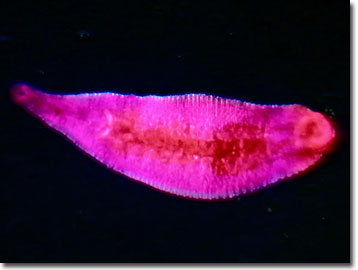Darkfield Digital Image Gallery
Leeches
Leech is a common name for over 650 species of largely freshwater, carnivorous worms that comprise the class Hirudinea in the phylum Annelida. Although commonly known as the bloodsuckers, some species are not parasitic and are free-living in streams and ponds, feeding on aquatic insects and other freshwater invertebrates.

View a high magnification image of a leech.
Leeches are found most often in stagnant freshwater ponds, but can also be found on land and in saltwater habitats. They do not have gills or lungs, but rather breath through their skin. Aquatic leeches can swim in an undulating fashion resembling movement of a ribbon, or crawl by looping, but land leeches move over solid surfaces by muscular expansion and contraction. Most leeches are negatively phototropic, very sensitive to movement in the water, and locate potential prey and mates by chemoreception.
While many aquatic leeches feed on the blood of fishes, amphibians, birds, mammals, snails, insect larvae, and worms, true land leeches feed only on the blood of mammals. Blood-feeding leeches retain the solid parts of the blood as food in their very large crops, while the leech's kidneys eliminate the blood fluid. A leech can hold up to three times its weight in blood.
Parasitic leeches are equipped with a large (caudal) and a small (oral) sucker. The mouth is located on the small sucker and has three jaws with sharp teeth that make a Y-shaped incision in the flesh. When the leech punctures the skin it anesthetizes the wound with its saliva, so that often the victim doesn't feel the puncture. In addition, the leech's saliva dilates the blood vessels to increase blood flow and prevent the blood from clotting. This anticoagulant is called hirudin and has been used for medicinal purposes for centuries.
First described in Ancient Greece, "blood-letting" with the aid of leeches reached its maximum popularity in nineteenth century Europe. It was used to treat many ailments such as pain, skin disorders, and high blood pressure. A common treatment for headaches, predating aspirin, was to apply several leeches to each temple and allow them to remove the "tainted" blood. This leech craze contributed to the depletion of the European population of medicinal leeches. Today, leeches are used after microsurgery to reduce blood congestion in damaged tissue. Often, blood can flow into the tissue but cannot flow out because of swollen, blocked veins. Attaching leeches to the affected area effectively removes the old blood until the outgoing blood vessels have healed. Research is also being conducted on leech saliva for its possible anti-cancer properties.
Leeches disperse via several methods. The most common is to remain attached to an animal such as a migrating fish, wading bird, or turtle, or an inanimate object such as a log as it moves to another location. Leeches are hermaphrodites, as are other annelids, and the fertilized eggs and encapsulated cocoons are attached to aquatic plants and leaves. During a flood or with normal outflow of a lake or downstream flow in a stream, leeches can quickly take hold and become abundant in a new habitat.
Contributing Authors
Cynthia D. Kelly, Thomas J. Fellers and Michael W. Davidson - National High Magnetic Field Laboratory, 1800 East Paul Dirac Dr., The Florida State University, Tallahassee, Florida, 32310.
BACK TO THE DARKFIELD IMAGE GALLERY
BACK TO THE DIGITAL IMAGE GALLERIES
Questions or comments? Send us an email.
© 1995-2025 by Michael W. Davidson and The Florida State University. All Rights Reserved. No images, graphics, software, scripts, or applets may be reproduced or used in any manner without permission from the copyright holders. Use of this website means you agree to all of the Legal Terms and Conditions set forth by the owners.
This website is maintained by our
Graphics & Web Programming Team
in collaboration with Optical Microscopy at the
National High Magnetic Field Laboratory.
Last Modification Friday, Nov 13, 2015 at 01:19 PM
Access Count Since September 17, 2002: 24200
Visit the website of our partner in introductory microscopy education:
|
|
